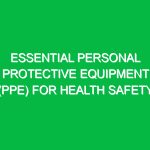Introduction
Hello Team,
Today’s Toolbox Talk is focused on an essential topic that often gets overlooked: “Not a Big Deal Until It Is.” This phrase serves as a reminder that seemingly minor issues can escalate into significant problems if not addressed promptly and adequately. In the realm of Health, Safety, and Environment (HSE), this concept is crucial for maintaining a safe workplace and preventing accidents.
Throughout this talk, we will explore the implications of this phrase in our daily operations, discuss how to identify potential Hazards, and share Best Practices to ensure a safe working environment. Let’s dive in!
The Importance of “Not a Big Deal Until It Is”
In our line of work, it’s easy to dismiss small issues as inconsequential. However, this mindset can lead to serious Safety breaches. For instance, a small oil spill may seem trivial at first, but if not cleaned up immediately, it can cause slips, trips, and falls, leading to injuries. This is a classic example of how a minor oversight can turn into a major incident.
By adopting the attitude of “Not a Big Deal Until It Is,” we can proactively address potential Hazards before they escalate. This approach not only promotes Safety but also enhances our overall work environment, ensuring that we all return home safely at the end of the day.
Identifying Potential Hazards
To effectively implement this mindset, it is vital to be able to identify potential hazards within the workplace. Here are some common examples:
- Obstructed pathways: Items left in walkways may seem like a minor inconvenience but can lead to serious accidents.
- Improperly stored materials: Materials that are not stored safely can fall and cause injuries.
- Defective equipment: A small malfunction might not seem urgent, but it can lead to equipment failure and severe injuries.
Encouraging an environment where employees feel comfortable reporting these “small” issues can help prevent them from becoming significant problems. Always remember: if you see something, say something!
Real-Life Examples
Let’s take a closer look at some real-life examples that illustrate the importance of addressing small issues:
- Example 1: A worker notices a frayed electrical cord in the workshop. They think it’s not a big deal and ignore it. Later, the cord sparks, leading to a fire that damages equipment and puts lives at risk. If the worker had reported it immediately, the issue could have been resolved safely.
- Example 2: A team member sees a small puddle of water on the floor but decides to wait until the end of the shift to clean it up. Someone later slips and falls, resulting in an injury. Had the puddle been addressed promptly, the accident could have been avoided.
These examples highlight how neglecting small issues can lead to significant consequences. By fostering a culture of safety and accountability, we can mitigate these risks effectively.
Best Practices for Addressing Small Issues
Here are some Best Practices to help you cultivate the “Not a Big Deal Until It Is” mindset:
- Stay vigilant: Always be on the lookout for potential hazards in your work environment. Regularly inspect your workspace for anything unusual.
- Report issues immediately: If you notice a minor problem, report it to your supervisor or safety officer right away. Prompt communication is key to preventing accidents.
- Participate in safety Training: Engage in regular safety training sessions to stay updated on best practices and Procedures. Knowledge is power when it comes to safety.
- Encourage open communication: Foster a workplace culture where everyone feels comfortable discussing safety concerns without fear of repercussions.
Regulations and Standards
Understanding relevant Regulations and standards is critical for maintaining Workplace Safety. Compliance with Occupational Safety and Health Administration (OSHA) regulations, for example, helps ensure that all employees are provided a safe working environment. Regular inspections, safety audits, and adherence to safety protocols are essential components of compliance.
When we collectively commit to following these standards, we not only protect ourselves but also our colleagues and the organization as a whole. Ignoring minor issues can lead to violations that result in penalties or more severe consequences.
Creating a Culture of Safety
Creating a culture of safety within our organization requires participation from everyone. Here are a few strategies to promote this culture:
- Lead by example: Management should demonstrate a commitment to safety by addressing minor issues promptly and prioritizing safety in all operations.
- Incorporate safety into daily routines: Make safety discussions a regular part of your team meetings. Encourage employees to share any concerns or observations.
- Recognize safe behavior: Acknowledge and reward employees who actively promote safety. Recognition can motivate others to follow suit.
Actionable Insights and Guidelines
Here are some actionable insights to keep in mind:
- Conduct daily safety checks: Take a few moments each day to inspect your workspace for hazards.
- Participate in safety drills: Regularly engage in safety drills to ensure that everyone knows how to respond in case of an emergency.
- Document safety incidents: Keep a log of any safety incidents, no matter how minor, to identify patterns and areas for improvement.
Open-Ended Questions for Discussion
As we wrap up today’s Toolbox Talk, I’d like to encourage some discussion. Here are a few questions to consider:
- Can you think of a time when a minor issue escalated into a bigger problem in your experience?
- What small hazards have you noticed in your work area recently?
- How can we improve our reporting processes to ensure minor issues are addressed quickly?
Conclusion
In conclusion, the phrase “Not a Big Deal Until It Is” serves as a vital reminder of the importance of addressing small issues in our workplace. By fostering a culture of safety, being vigilant, and encouraging open communication, we can prevent minor problems from escalating into major accidents. Remember, every small action we take contributes to a safer work environment for everyone.
Thank you all for your attention and your commitment to maintaining a safe workplace. Let’s continue to work together to ensure that we all return home safe and sound at the end of the day.


